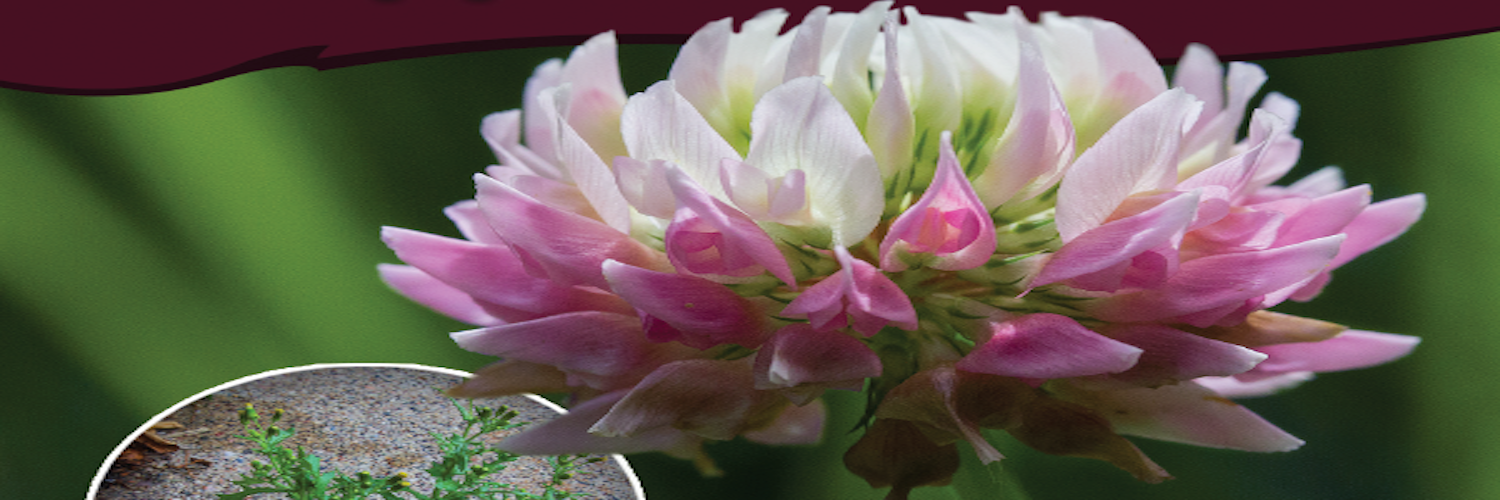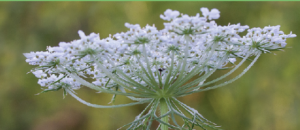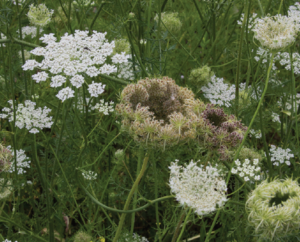
Common Backyard Weeds of the Upper Midwest
Teresa Marrone has been gathering and preparing wild edibles for three decades, and we are excited about her new book Common Backyard Weeds of the Upper Midwest.
Hundreds of full-color photos with easy-to-understand text make this a great visual guide to learning about nearly 60 species of common weeds—toxic, edible, or otherwise interesting—found in the Upper Midwest, including Illinois, Indiana, Iowa, Michigan, Minnesota, North Dakota, Ohio, South Dakota, and Wisconsin.
 Today we take a look at Queen Anne’s Lace. The distinctive part of this non-native biennial is the second-year flowering plant, which is 2 to 4 feet tall. Its slender green stem is hairy and has fine vertical lines. It often grows in large colonies; in sunny, dry areas, including yards, gardens, parks, and waste areas; and in fields, on railroad embankments, and along roads. It is very common in the southeastern two-thirds of our region and is listed as a noxious weed in Iowa, Michigan, and Ohio.
Today we take a look at Queen Anne’s Lace. The distinctive part of this non-native biennial is the second-year flowering plant, which is 2 to 4 feet tall. Its slender green stem is hairy and has fine vertical lines. It often grows in large colonies; in sunny, dry areas, including yards, gardens, parks, and waste areas; and in fields, on railroad embankments, and along roads. It is very common in the southeastern two-thirds of our region and is listed as a noxious weed in Iowa, Michigan, and Ohio.
The compound, fern-like leaves are sparsely hairy underneath. The first-year basal cluster is a rosette that looks like a carrot top. Leaves of second-year flowering plants grow alternately, attached to a sheath that connects to the main stem. Leaflets are divided into additional segments; some segments are flat, with additional small, flat lobes, while others are more feathery. Lower leaves are twice compound and up to 10 inches long, with thin, feathery leaflets.
The flat-topped floral clusters (umbels), 2 to 5 inches across, grow on leafless stalks from stem ends. The large clusters are made up of smaller clusters of 1⁄8-inch white flowers. The large cluster often has a few dark purple flowers in the center. The stemlets of all clusters join together at the top of the floral stalk. Long, thin green bracts grow below the cluster. As they mature, clusters turn brown and curl inward, forming a bird’s-nest shape that is filled with ribbed seeds.
Queen Anne’s Lace, also known as Wild Carrot or Chigger Weed, flowers continuously from summer through early fall.
 Getting Rid of It!
Getting Rid of It!
Queen Anne’s Lace can be pulled when young; as the plants mature, they develop a deep taproot that can be difficult to completely remove. New plants will sprout from any root remnants, so it’s worth it to try to dig them out with a narrow-bladed spade. Large infestations can be mowed when the plants start flowering, but this may need to be repeated. Whatever you do, don’t let the plants go to seed; they will spread wildly. Queen Anne’s Lace is known to harbor chiggers, so watch out when weeding!
What’s It Good For?
The flowers are used to make jelly; be certain you have picked flowers of Queen Anne’s Lace—not deadly Poison Hemlock! Roots of the first-year plant can be cooked like carrots, but they are reportedly stringy and tough.
If you are interested to learn how to identify backyard weeds, check out Common Backyard Weeds of the Upper Midwest by Teresa Marrone.


